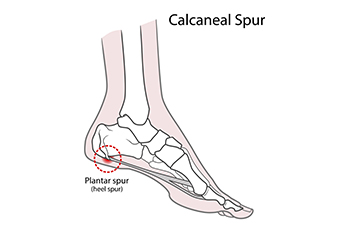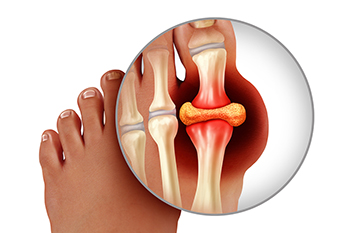Items filtered by date: June 2025
Common Foot and Ankle Injuries for Golfers

Golfers are at risk of developing foot and ankle injuries usually due to the repeated motions involved in swinging the club. One foot issue common to golfers is intermetatarsal neuroma, a painful nerve condition in the forefoot caused by pressure during the swing, often affecting the non-dominant foot. Another problem is lateral ankle pain, which results from repeated motion during follow-through. As the body rotates, the back foot often rolls outward, termed supination, while the heel moves slightly inward. These combined forces can strain the ankle ligaments and surrounding tendons. Golfers may also develop subungual hematomas, which are collections of blood beneath the toenail, typically under the big toe of the dominant foot, caused by repeated pressure during the swing. Even driving the golf cart can lead to top-of-foot pain, especially if the brake is used heavily. A podiatrist can diagnose these issues and recommend effective treatment. If you believe you have foot or ankle pain related to playing golf, it is suggested that you schedule an appointment with a podiatrist, who can offer appropriate relief and treatment solutions.
Ankle and foot injuries are common among athletes and in many sports. They can be caused by several problems and may be potentially serious. If you are feeling pain or think you were injured in a sporting event or when exercising, consult with one of our podiatrists from Arcadia Foot and Ankle. Our doctors will assess your condition and provide you with quality foot and ankle treatment.
Common Injuries
The most common injuries that occur in sporting activities include:
- Achilles Tendonitis
- Achilles Tendon Rupture
- Ankle Sprains
- Broken Foot
- Plantar Fasciitis
- Stress Fractures
- Turf Toe
Symptoms
Symptoms vary depending upon the injury and in some cases, there may be no symptoms at all. However, in most cases, some form of symptom is experienced. Pain, aching, burning, bruising, tenderness, tightness or stiffness, sensation loss, difficulty moving, and swelling are the most common symptoms.
Treatment
Just as symptoms vary depending upon the injury, so do treatment options. A common treatment method is known as the RICE method. This method involves rest, applying ice, compression and elevating the afflicted foot or ankle. If the injury appears to be more serious, surgery might be required, such as arthroscopic or reconstructive surgery. Lastly, rehabilitation or therapy might be needed to gain full functionality in the afflicted area. Any discomfort experienced by an athlete must be evaluated by a licensed, reputable medical professional.
If you have any questions please contact our offices located in Scottsdale, North Scottsdale, Mesa, and Sun City, AZ . We offer the newest diagnostic and treatment technologies for all your foot and ankle needs.
What Is a Heel Spur?

A heel spur is a bony growth that forms on the underside of the heel bone, often due to long-term strain on foot muscles and ligaments. It is commonly associated with plantar fasciitis and may not cause symptoms, but when it does, it can result in sharp pain during walking or standing. Risk factors include obesity, flat feet, high-impact activities, and wearing poorly fitted footwear. A podiatrist can assess heel pain through imaging and physical evaluation, then recommend treatments such as orthotics or stretching exercises. If you are experiencing persistent heel discomfort, it is suggested that you consult a podiatrist for a personalized plan to relieve pain and prevent further complications.
Many people suffer from bouts of heel pain. For more information, contact one of our podiatrists of Arcadia Foot and Ankle. Our doctors can provide the care you need to keep you pain-free and on your feet.
Causes of Heel Pain
Heel pain is often associated with plantar fasciitis. The plantar fascia is a band of tissues that extends along the bottom of the foot. A rip or tear in this ligament can cause inflammation of the tissue.
Achilles tendonitis is another cause of heel pain. Inflammation of the Achilles tendon will cause pain from fractures and muscle tearing. Lack of flexibility is also another symptom.
Heel spurs are another cause of pain. When the tissues of the plantar fascia undergo a great deal of stress, it can lead to ligament separation from the heel bone, causing heel spurs.
Why Might Heel Pain Occur?
- Wearing ill-fitting shoes
- Wearing non-supportive shoes
- Weight change
- Excessive running
Treatments
Heel pain should be treated as soon as possible for immediate results. Keeping your feet in a stress-free environment will help. If you suffer from Achilles tendonitis or plantar fasciitis, applying ice will reduce the swelling. Stretching before an exercise like running will help the muscles. Using all these tips will help make heel pain a condition of the past.
If you have any questions, please feel free to contact our offices located in Scottsdale, North Scottsdale, Mesa, and Sun City, AZ . We offer the newest diagnostic and treatment technologies for all your foot care needs.
Stages of Gout and the Podiatrist’s Role in Care

Gout is a form of arthritis caused by the buildup of uric acid crystals in the joints, often affecting the feet. It progresses through four stages known as asymptomatic hyperuricemia, acute gout, intercritical gout, and chronic tophaceous gout. Risk factors include a diet high in purines, obesity, alcohol use, certain medications, and genetic predisposition. Symptoms involve sudden, intense joint pain, swelling, redness, and warmth, usually in the big toe. A podiatrist can help manage gout through joint evaluation, medication recommendations, and dietary guidance. They can also treat complications such as joint damage and tophi, helping to relieve pain, prevent flare-ups, and maintain foot function and mobility. If you have had one or more gout flare ups, it is strongly suggested that you are under the care of a podiatrist who can help you to manage this painful condition.
Gout is a painful condition that can be treated. If you are seeking treatment, contact one of our podiatrists from Arcadia Foot and Ankle. Our doctors will treat your foot and ankle needs.
What Is Gout?
Gout is a form of arthritis that is characterized by sudden, severe attacks of pain, redness, and tenderness in the joints. The condition usually affects the joint at the base of the big toe. A gout attack can occur at any random time, such as the middle of the night while you are asleep.
Symptoms
- Intense Joint Pain - Usually around the large joint of your big toe, and it most severe within the first four to twelve hours
- Lingering Discomfort - Joint discomfort may last from a few days to a few weeks
- Inflammation and Redness -Affected joints may become swollen, tender, warm and red
- Limited Range of Motion - May experience a decrease in joint mobility
Risk Factors
- Genetics - If family members have gout, you’re more likely to have it
- Medications - Diuretic medications can raise uric acid levels
- Gender/Age - Gout is more common in men until the age of 60. It is believed that estrogen protects women until that point
- Diet - Eating red meat and shellfish increases your risk
- Alcohol - Having more than two alcoholic drinks per day increases your risk
- Obesity - Obese people are at a higher risk for gout
Prior to visiting your podiatrist to receive treatment for gout, there are a few things you should do beforehand. If you have gout you should write down your symptoms--including when they started and how often you experience them, important medical information you may have, and any questions you may have. Writing down these three things will help your podiatrist in assessing your specific situation so that he or she may provide the best route of treatment for you.
If you have any questions, please feel free to contact our offices located in Scottsdale, North Scottsdale, Mesa, and Sun City, AZ . We offer the newest diagnostic and treatment technologies for all your foot care needs.
We Can Treat Your Foot or Ankle Pain
What to Expect From Morton’s Neuroma Surgery

Morton’s neuroma is a painful condition caused by a thickened nerve between the toes, often triggered by irritation or pressure. When conservative treatments do not provide relief, foot surgery may be recommended to remove the affected nerve or release the surrounding tissue. Surgery offers long-term pain relief and allows many patients to return to normal activities without discomfort. The procedure is typically performed on an outpatient basis and has a high success rate. Recovery usually involves rest, limited weight-bearing, and a gradual return to walking, over several weeks. Swelling and tenderness are normal during healing, but improve with time. A podiatrist can determine if surgery is the best option and guide you through recovery. If you have ongoing forefoot pain, it is suggested that you consult a podiatrist for expert care and appropriate treatment options.
Foot surgery is sometimes necessary to treat a foot ailment. To learn more, contact one of our podiatrists of Arcadia Foot and Ankle. Our doctors will assist you with all of your foot and ankle needs.
When Is Surgery Necessary?
Foot and ankle surgery is generally reserved for cases in which less invasive, conservative procedures have failed to alleviate the problem. Some of the cases in which surgery may be necessary include:
- Removing foot deformities like bunions and bone spurs
- Severe arthritis that has caused bone issues
- Cosmetic reconstruction
What Types of Surgery Are There?
The type of surgery you receive will depend on the nature of the problem you have. Some of the possible surgeries include:
- Bunionectomy for painful bunions
- Surgical fusion for realignment of bones
- Neuropathy decompression surgery to treat nerve damage
Benefits of Surgery
Although surgery is usually a last resort, it can provide more complete pain relief compared to non-surgical methods and may allow you to finally resume full activity.
Surgical techniques have also become increasingly sophisticated. Techniques like endoscopic surgery allow for smaller incisions and faster recovery times.
If you have any questions, please feel free to contact our offices located in Scottsdale, North Scottsdale, Mesa, and Sun City, AZ . We offer the newest diagnostic and treatment technologies for all your foot care needs.
